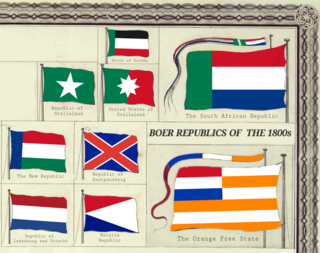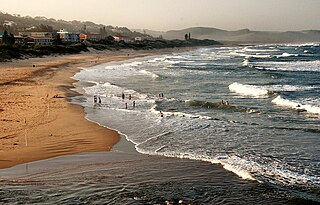
KwaZulu-Natal is a province of South Africa that was created in 1994 when the Zulu bantustan of KwaZulu and Natal Province were merged. It is located in the southeast of the country, with a long shoreline on the Indian Ocean and sharing borders with three other provinces and the countries of Mozambique, Eswatini and Lesotho. Its capital is Pietermaritzburg, and its largest city is Durban. It is the second-most populous province in South Africa, with slightly fewer residents than Gauteng.

The Great Trek was a northward migration of Dutch-speaking settlers who travelled by wagon trains from the Cape Colony into the interior of modern South Africa from 1836 onwards, seeking to live beyond the Cape's British colonial administration. The Great Trek resulted from the culmination of tensions between rural descendants of the Cape's original European settlers, known collectively as Boers, and the British Empire. It was also reflective of an increasingly common trend among individual Boer communities to pursue an isolationist and semi-nomadic lifestyle away from the developing administrative complexities in Cape Town. Boers who took part in the Great Trek identified themselves as voortrekkers, meaning "pioneers", "pathfinders" in Dutch and Afrikaans.

The Boer republics were independent, self-governing republics formed by Dutch-speaking inhabitants of the Cape Colony and their descendants. The founders – variously named Trekboers, Boers and Voortrekkers – settled mainly in the middle, northern, north-eastern and eastern parts of present-day South Africa. Two of the Boer Republics achieved international recognition and complete independence: the South African Republic and the Orange Free State. The republics did not provide for the separation of church and state, initially allowing only the Dutch Reformed Church, and later also other Protestant churches in the Calvinist tradition. The republics came to an end after the Second Boer War of 1899–1902, which resulted in British annexation and later incorporation of their lands into the Union of South Africa.

Andries Wilhelmus Jacobus Pretorius was a leader of the Boers who was instrumental in the creation of the South African Republic, as well as the earlier but short-lived Natalia Republic, in present-day South Africa. The large city of Pretoria, executive capital of South Africa, is named after him.

The Natalia Republic was a short-lived Boer republic founded in 1839 after a Voortrekker victory against the Zulus at the Battle of Blood River. The area was previously named Natália by Portuguese sailors, due to its discovery on Christmas. The republic came to an end in 1843 when British forces annexed it to form the Colony of Natal. After the British annexation of the Natalia Republic, most local Voortrekkers trekked northwest into Transorangia, later known as the Orange Free State, and the South African Republic.

Estcourt is a town in the uThukela District of KwaZulu-Natal Province, South Africa. The main economic activity is farming with large bacon and processed food factories situated around the town. The N3 freeway passes close to the town, linking it to the rest of South Africa.

Scottburgh is a coastal resort town located along the south coast of KwaZulu-Natal, South Africa. It situated south of the mouth of the Mpambanyoni River (confuser of birds).
Westville is an area in KwaZulu-Natal, South Africa, and is just west and 10 km inland from the Durban CBD. It was a formerly independent municipality however it became part of the eThekwini Metropolitan Municipality in 2002.

Nutbush is a rural unincorporated community in Haywood County, Tennessee, United States, in the western part of the state, approximately 50 miles northeast of Memphis. It was established in the early 19th century by European-American settlers who bought enslaved African Americans to develop the area's cotton plantations. The houses and churches that were built during this time still stand.

The Colony of Natal was a British colony in south-eastern Africa. It was proclaimed a British colony on 4 May 1843 after the British government had annexed the Boer Republic of Natalia, and on 31 May 1910 combined with three other colonies to form the Union of South Africa, as one of its provinces. It is now the KwaZulu-Natal province of South Africa.

Richard Philip King (1811–1871) was an English trader and colonist at Port Natal, a British trading station in the region now known as KwaZulu-Natal. He is best known for a historic horseback ride in 1842, where he completed a journey of 960 kilometres (600 mi) in 10 days, to request help for the besieged British garrison at Port Natal. In recognition of his heroic deeds, a statue was unveiled in Durban portraying himself riding his horse 'Sunny’. Additionally, he was bestowed with an estate in Isipingo. Several prominent landmarks in Durban, including the Kings Park Rugby Stadium, Kingsmead Cricket Stadium, the former soccer stadium, and Kingsway High School, were named in his honour.

Wilhelm Gueinzius was a German naturalist, collector and apothecary.
Jacob Ludwig Döhne, from the Berlin Missionary Society, who was responsible for compiling A Zulu-Kafir Dictionary after spending twenty years documenting the language and dialects. He also translated the New Testament into Xhosa and Zulu.

Karl/Carl Wilhelm Posselt, was a German missionary from the Berlin Missionary Society and was active in South Africa where he became known as "the missionary with the violin".
Hermannsburg is a small hamlet located in the Province of KwaZulu-Natal in South Africa. It is home to the Hermannsburg School.

Daniel Lindley was an American missionary in South Africa. He and his wife Lucy founded the Inanda Seminary School in 1869. Lindley was pastor to the first Dutch Reformed Church in the Orange Free State. He was a pastor to the Voortrekkers.

Lüneburg is a farming community in eDumbe Local Municipality in the KwaZulu-Natal province of South Africa.
German South Africans refers to South Africans who have full or partial German heritage.
The Zulu Congregational Church is a Congregational Church in South Africa.
Johann Heinrich Christoph Johannes was born on 16 August 1852 in the Lower Saxony state, Germany and died on 13 September 1943, in the Eastern Transvaal South Africa He was a missionary in eNyathi, Colony of Natal, South Africa.
















